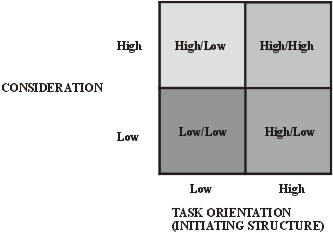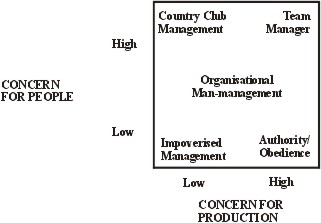|
Leadership & Management Styles |
|
Leadership and Motivation |
| Leadership is the art or process of influencing people so that they perform assigned tasks willingly and in an efficient and effective manner. |
|
| According to Gary Yukl (Leadership in Organisations) successful leaders are capable of adapting to changed circumstances, aware of the social environment, ambitious and assertive, willing to co-operate with others and decisive when making decisions. They can be trusted, they tend to assume a dominant role with a group, and they have energy and are persistent. They have self-confidence, they can absorb a great deal of stress and they are willing to take on a role of responsibility. |
|
| Leaders tend to be intelligent, creative, to have tact and diplomacy, possess good communication skills and to be persuasive, to be knowledgeable, to possess good social skills, to possess self-discipline and be capable of organizing things. |
|
|
|
Lewin, Lippit and White's Study of Leadership Styles |
| Lewis, Lippit and White made a famous study of leadership styles: Boys at model-making clubs were led by adults who acted in one of three ways: autocratic, democratic or laissez-faire. |
|
|
|
| • | | Autocratic leaders told the boys what sort of models they would make. They sometimes praised or blamed them but did not explain their comments. |
| • | | Democratic leaders discussed various possible projects and allowed the boys to make their own decisions. They explained their comments. |
| • | | Laissez-faire leaders left the boys very much to their own devices. |
|
|
| The findings were as follows: |
|
| Boys with an autocratic leader became aggressive towards each other and were submissive in their approaches to the leader. |
|
| Boys with a democratic leader got on much better with each other. Although slightly less work was actually done, approaches to the leader were usually task-related. |
|
| Boys with a laissez-faire leader were aggressive towards each other. Very little work was done. |
|
Leadership Style: Task orientated or person centred |
| Whilst the study by Lewin, Lippit and White indicates that the laissez-faire approach is not really a form of leadership at all, but rather a neglect of duty, it also shows that there is some choice in leadership style between |
|
| • | | The Authoritarian style: This is also called the task centred approach to leadership. The leader is concerned to get tasks completed. He is authoritarian and assumes responsibility for all aspects of the work process. Communication tends to be “one-way”. |
|
| • | | Democratic style: This is also called a person centred approach to leadership. The leader is concerned with team harmony and group cohesion. He seeks the opinions of subordinates and strives for mutual understanding. |
|
|
| The authoritarian style is associated with the Classical Theory of Motivation, whereas the democratic style is associated with the Human Relations Theory of Motivation. |
|
| There has been some tendency to favour the democratic style of leadership in modern times (post Second World War). |
|
| However, there is also a recognition that the effectiveness and choice of leadership style depends on the nature of the task, and this leads to Fiedler's Contingency Model. |
|
Fiedler`s Contingency Model |
| Fiedler`s studies led to the conclusion that a task-orientated manager will be the most effective when |
|
| • | | Relations are good, the task is highly structured, and the leader has substantial power and authority
|
| • | | And when the complete opposite applies.
|
|
|
| In situations where relations are only moderately good, and the leader has a degree of power and authority, then the relations approach (as discussed in the Ohio State Studies below) is deemed to be more suitable. |
|
Robert House |
| House's Path-Goal theory suggests that the most effective leaders are those who show employees how their performance will lead directly to tangible results. In House`s study two broad factors determine the appropriate leadership style |
|
| • | | Characteristics of the subordinate — age, ability, acceptance of authority
|
|
| • | | Environmental factors — nature of the task, structure of the organisation. A general rule is that employees performing routine and highly structured tasks prefer a supportive leader, whereas employees performing unstructured tasks prefer a leader who directs the workforce.
|
|
|
Ohio State Studies and the Managerial grid |
| Researchers at Ohio State University in the 1940s developed a two-dimensional matrix to analyse leadership effectiveness. One dimension was task-orientated behaviour and the other was consideration for employees. Task orientated behaviour includes establishing policies, seeing that deadlines are met, exerting pressure, and emphasising performance. Considerate behaviour included praising, listening, explaining and seeking opinions. Leaders could then be placed into a box on the matrix according to their skills. |
|

|
|
| Research suggests that a leader who is high on both dimensions is seen as the most effective by subordinates. |
|
| Robert Blake and Jane Mouton developed this matrix into a grid, and identified five positions in the grid corresponding to different types of leadership.
|
|
 |
|
| Again, the implication is that the best form of leadership is the provided by the “Team Manager” who expresses both high concern for people and high concern for the task. |
|
Rensis Likert |
| Rensis Likert identified four management styles |
|
| • | | Benevolent authoritarian, where management is by carrot rather than stick, but subordinates are still basically subservient
The exploitative, authoritarian, style where management is by fear and coercion, and communication is top-down
|
|
| • | | Consultative, where management uses both carrot and stick and does talk to employees
|
|
| • | | Participative, where management provides economic rewards and is concerned to get employees involved in groups capable of making decisions.
|
|
|
| Likert claims that supervisors with the best record of performance tend to be those who are “employee centred”, to regard their chief task as dealing with people rather than work and who focus on building effective work groups that in turn were set high achievement goals. |
|
Leaders and Managers |
| It is useful to distinguish between managers and leaders; managers have legitimate or positional power as a result of their post. However, for leaders the source of their ability to influence others comes from their expertise or from their personality. It is possible to be a leader without being a manager, and possible to be a manager with no leadership skills. On the other hand, the best managers are also leaders. |
|
John Adair |
| John Adair claimed that people can be trained for leadership as a transferable skill and that leadership is not a matter of inborn aptitude. The central skills are decision-making, communication, and the ability to manage time. In his action-centred learning model he argues that working groups share three areas of common needs: the need to accomplish a common task, the need to be maintained as a cohesive social unit or team, and the sum of the group's individual needs. The functions of leadership are: planning and initiating, controlling and supporting, informing and evaluating. |
|
Warren Bennis |
| Warren Bennis argues that whereas managers do things right, leaders do the right thing. Leadership can be taught and learned. The best leaders are ‘ideas people, conceptualists'. The most impressive and memorable quality of a leader is the way he responds to failure. Leaders don't think in terms of failure. |
|
Functions of management |
| A useful list of some of the functions of management is as follows: |
|
| Manage personnel: (1) Employee resourcing; (2) Training and development; (3) Pay; (4) Employee relations. |
|
| Production and Operations management: (1) Purchasing of raw materials and input goods and services; (2) Research and development; (3) Distribution; (4) Design, planning, operation and control of production |
|
| Financial and accounting |
|
| Marketing |
|
Mintzberg's Managerial Roles |
| Managers perform “roles”. Mintzberg identifies the following managerial roles |
|
| Interpersonal Roles: Figure-head, Leader, Liaison Officer |
|
| Informational Roles |
|
| Monitors: Disseminators, Spokespeople
|
|
| Decisional Roles: Entrepreneurs, Disturbance handlers, Resource allocators, Negotiators |
|